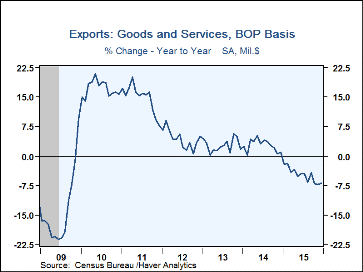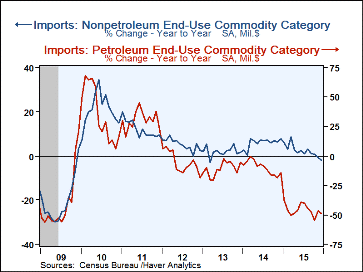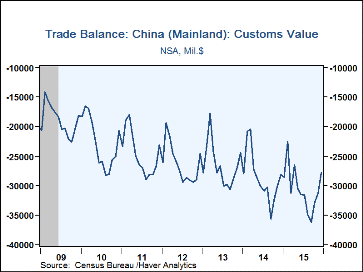 Global| Mar 04 2016
Global| Mar 04 2016U.S. Trade Deficit Widens Slightly in December
Summary
The U.S. foreign trade deficit increased to $43.4 billion in December from November's $42.2 billion, which was revised from $42.4 billion. The December result was modestly larger than the Action Economics Forecast Survey estimate of [...]
 The U.S. foreign trade deficit increased to $43.4 billion in December from November's $42.2 billion, which was revised from $42.4 billion. The December result was modestly larger than the Action Economics Forecast Survey estimate of $42.9 billion. The trade deficit for all of 2015 was $531.5 billion, following $508.3 billion in 2014. The December deficit in goods widened to $62.5 billion from $61.2 billion in November. The surplus in services increased to $19.2 billion from $19.0 billion. The wider overall deficit in December resulted from somewhat adverse moves in both exports and imports, as exports of goods and services decreased 0.3%, while imports rose 0.3%.
The U.S. foreign trade deficit increased to $43.4 billion in December from November's $42.2 billion, which was revised from $42.4 billion. The December result was modestly larger than the Action Economics Forecast Survey estimate of $42.9 billion. The trade deficit for all of 2015 was $531.5 billion, following $508.3 billion in 2014. The December deficit in goods widened to $62.5 billion from $61.2 billion in November. The surplus in services increased to $19.2 billion from $19.0 billion. The wider overall deficit in December resulted from somewhat adverse moves in both exports and imports, as exports of goods and services decreased 0.3%, while imports rose 0.3%.
Among exports of goods, all end-use categories fell except non-auto consumer goods, which rose 5.9% in December. The declines included autos, which dropped 4.4%, foods, feeds & beverages by 3.6%, "other" by 3.1%, industrial supplies and materials by 1.3% and capital goods by 0.8%. Imports of goods were mixed, with autos showing the largest increase, 3.4%, followed by foods, feeds & beverages, 1.7%, and industrial supplies and materials, 1.4%. "Other" goods imports fell 5.8%, consumer goods by 1.3% and capital goods by 0.1%. The petroleum end-use category rose in December by 2.0% following November's 5.6% increase.
The real trade deficit in goods (in chained 2009 dollars) widened in December to $60.3 billion from November's $59.2 billion. Imports rose 0.8% while exports also rose, but less, by 0.2%.
The surplus in services resulted from an increase in exports of 0.5% and a smaller increase in imports of 0.3%. Financial services provided to other countries' residents had the biggest increase among exports, 2.4%. Travel abroad had the largest increase among import categories, 1.4%.
By country, the trade deficit in goods with China decreased noticeably, to $27.9 billion in December from $31.3 billion in November. However, December's exports to China were down 16.8% from a year ago, while imports were down 5.5%. The deficit with Japan widened a bit in December to $6.6 billion from $5.7 billion the month before; exports there were down 17.5% from a year ago and imports down 0.9%. Goods trade with the European Union had little change in the deficit, with $13.7 billion in December versus $13.8 billion in November. Exports to the EU were off 1.5% from a year ago and imports were down 0.2%.
The international trade data can be found in Haver's USECON database. Detailed figures are available in the USINT database. The expectations figures are from the Action Economics Forecast Survey, which is carried in the AS1REPNA.
| Foreign Trade in Goods & Services (Current Dollars) | Jan | Dec | Nov | Y/Y | 2015 | 2014 | 2013 |
|---|---|---|---|---|---|---|---|
| U.S. Trade Deficit | $44.6 bil. | $43.4 bil. | $42.2 bil. | $45.5 bil. (1/15) |
$531.5 bil. | $508.3 | $478.4 bil. |
| Exports of Goods & Services (% Chg) | -1.6 | -0.3 | -0.9 | -6.9 | -4.8 | 2.8 | 2.8 |
| Imports of Goods & Services (% Chg) | -0.4 | 0.3 | -1.8 | -6.5 | -3.1 | 3.4 | 0.1 |
| Petroleum | -13.2 | 2.0 | 5.6 | -48.7 | -45.5 | -9.7 | -11.0 |
| Nonpetroleum | 0.6 | 0.2 | -2.6 | -1.8 | 2.3 | 6.1 | 2.0 |
Carol Stone, CBE
AuthorMore in Author Profile »Carol Stone, CBE came to Haver Analytics in 2003 following more than 35 years as a financial market economist at major Wall Street financial institutions, most especially Merrill Lynch and Nomura Securities. She has broad experience in analysis and forecasting of flow-of-funds accounts, the federal budget and Federal Reserve operations. At Nomura Securites, among other duties, she developed various indicator forecasting tools and edited a daily global publication produced in London and New York for readers in Tokyo. At Haver Analytics, Carol is a member of the Research Department, aiding database managers with research and documentation efforts, as well as posting commentary on select economic reports. In addition, she conducts Ways-of-the-World, a blog on economic issues for an Episcopal-Church-affiliated website, The Geranium Farm. During her career, Carol served as an officer of the Money Marketeers and the Downtown Economists Club. She has a PhD from NYU's Stern School of Business. She lives in Brooklyn, New York, and has a weekend home on Long Island.









